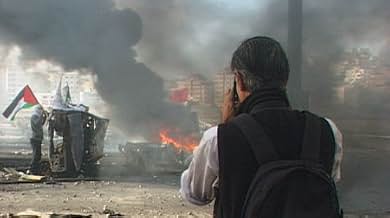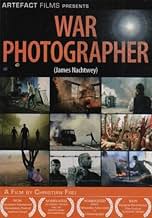Ajouter une intrigue dans votre langueDocumentary about war photographer James Nachtwey, considered by many the greatest war photographer ever.Documentary about war photographer James Nachtwey, considered by many the greatest war photographer ever.Documentary about war photographer James Nachtwey, considered by many the greatest war photographer ever.
- Nommé pour 1 oscar
- 7 victoires et 4 nominations au total
Avis en vedette
As such, while I have profound respect for Nachtwey's efforts, his results and evidently his civility in the face of brutality, this film I think is not an essential watch. If you are like me, and feel it is important to remind yourself of how privileged your existence is from time to time, this will suffice. But not as well as an afternoon at a soup kitchen...
I think there is no doubt as to the bravery of a war photographer, in my naivete, I did not think that some folks saw them as crass profiteers until seeing this film (and reading some commentary online. "Vampirism" is addressed obliquely in the film. Well, all aspects are addressed obliquely in this film.
Back to "vampirism," again even if a person were greedy, that would not deny his/her bravery. As I write this, all I know is that Nachtwey was injured in early December along with Michael Weisskopf who allegedly was very heroic in harm's way. I've not seen many updates since the initial reports, and it's been nearly a month. At this time, I should also point out there is a jamesnachtwey.com with some of the photos from this film.
In hindsight, I would suggest viewing more photos, while reading the text of interviews with Nachtwey and skip this film.
There are some creative microcameras used to put us not only in Nachtwey's shoes, but in his lens. I found them quickly a distraction, if not an annoyance. And sometimes there would be a lengthy microcamera shot looking back at Nachtwey's brow, properly furrowed as he took in the atrocity at hand.
Images from a sulfur mine (moving from martial to capitalistic crimes?) were eerily beautiful, especially in video format. And video was another problem for me, personally I prefer it to photography. Whether for a wedding, or a war.
But video certainly in its elongation of time, rather than a snapshots snap moment, makes you wonder about the before and after of activities. We demand more from video, with photos we demand more from ourselves.
We see Palestinians with rocks, slingshots and molitov cocktails hurling blindly though smoke and over and around concrete. No story behind why they are there, and some of them seem quite young. A pet peeve of mine is why kids are allowed in harms way in such settings.
People in Jakarta are living near the train tracks, and one family is given specific focus. The message is that these people are just like you, striving to support their children...
But again the video makes me wonder about that family some more. The father has lost an arm and a leg to the trains that he now keeps his family living near by, and unlike the other families, in lean-to's off to the side of the tracks, they are shown "sleeping" right between the tracks.
These questions pop up with video, whereas I think a few photographs and Nachtwey's words voiced over or written in an article would not.
In conclusion, I feel somewhat conflicted giving this less than a 6, especially as I am more than likely aligned with the general beliefs of Nachtwey. His stated belief in the importance of one life is something that I think as individuals we have to try and assert knowing that governments and companies understand how cheap human life is.
That's a tricky balance, and one hard to put on video, possibly better left to a photo and then meditated upon by each one us. We do see many photos here, but then as they are "embedded" in video, they are tainted by that. It happens with embedding I think...the meter is running and the demands of the film must be met. Maybe I should have hit the pause button for each photo?
With hope, soon Nachtwey will be well from his wounds, and again able to document the wounds of the world for us.
5/10
And thus we see that in the war in Iraq the gov't is keeping a tight lid on images. Once you see pictures of a 4 year old boy in a morgue with his limbs blown off, the generals and the politicians cannot, no matter how hard they try, justify it. this is why Al Jazeera has become the boogeyman of the west.
once people see enough of these images, they cannot support war any longer. this, i believe, is Nachtwey's vision and his struggle.
The photographer, James Nachtwey, is a cool, philosophical individual, motivated by the goodness he feels motivates humanity--in spite of the horrors he deals with on the killing fields. We have all come across the trashy photos that adorn the covers of National Enquirer, pictures that titillate and appeal to our worst natures--Nachtwey's hard-earned photos do just the opposite--they appeal to our compassion, are meant to give us insight into the human condition, the humanity we all share--and in doing so elevate all of us, enrich humanity.
War Photographer is often a frankly brutal film, but it's overall impact is significantly uplifting. One greatly admires James Nachtway for his goals and is astonished by his photography.
It's also a very moving film--very intense. I certainly can't get through it without tearing up, and when I looked around the theater I saw the same shock and grief on the faces of my fellow moviegoers. The ethos of the film seems to reflect the sentiment behind Nachtwey's own photographs; that is, you don't get the New York Times explanation of who the victims are, who the perpetrators are, or what the socio-political context is. The violence and suffering are presented simply: this thing happened to this person at this moment, and it was awful.
It's not too preachy; the viewer is left to ask her own questions about why and how these things happen. Sometimes all those explanations can obscure the individual lives that are contained in a word like "collateral damage." Nachtwey's photography, and this film, clarify that fact simply by observing it. That's the essence of the best documentary photography, and it's a great reason to see this film.
Le saviez-vous
- Citations
James Nachtwey: It's more difficult to get publications to focus on issues that are more critical, that do not provide people with as escape from reality but attempt to get them deeper into reality. To be concerned about something much greater than themselves. And I think people are concerned. I think quite often, publishers don't give their audience enough credit for that. In fact, at the end of the day, I believe people do want to know when there's some major tragedy going on; when there's some unacceptable situation happening in this world. And they want something done about it. That's what I believe. We must look at it. We're required to look at it. We're requited to do what we can about it. If we don't, who will?
- ConnexionsFeatured in Docventures: Totuus (2014)
- Bandes originalesThe River
Composed by Eleni Karaindrou
Performed by String Orchestra
Conducted by Lefteris Halkiadakis (as Lefteris Chalkiadakis)
Meilleurs choix
- How long is War Photographer?Propulsé par Alexa
Détails
- Date de sortie
- Pays d’origine
- Site officiel
- Langues
- Aussi connu sous le nom de
- War Photographer
- Lieux de tournage
- sociétés de production
- Consultez plus de crédits d'entreprise sur IMDbPro
Box-office
- Brut – États-Unis et Canada
- 61 040 $ US
- Fin de semaine d'ouverture – États-Unis et Canada
- 9 327 $ US
- 23 juin 2002
- Brut – à l'échelle mondiale
- 86 863 $ US



















